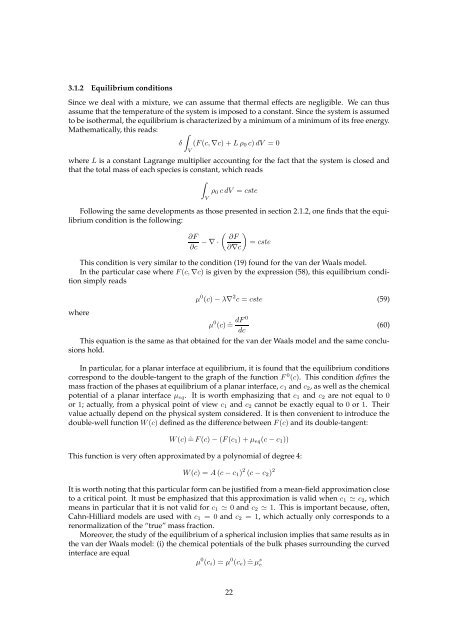Diffuse interface models in fluid mechanics
Diffuse interface models in fluid mechanics
Diffuse interface models in fluid mechanics
You also want an ePaper? Increase the reach of your titles
YUMPU automatically turns print PDFs into web optimized ePapers that Google loves.
3.1.2 Equilibrium conditionsS<strong>in</strong>ce we deal with a mixture, we can assume that thermal effects are negligible. We can thusassume that the temperature of the system is imposed to a constant. S<strong>in</strong>ce the system is assumedto be isothermal, the equilibrium is characterized by a m<strong>in</strong>imum of a m<strong>in</strong>imum of its free energy.Mathematically, this reads: ∫δ (F (c, ∇c) + L ρ 0 c) dV = 0Vwhere L is a constant Lagrange multiplier account<strong>in</strong>g for the fact that the system is closed andthat the total mass of each species is constant, which reads∫ρ 0 c dV = csteVFollow<strong>in</strong>g the same developments as those presented <strong>in</strong> section 2.1.2, one f<strong>in</strong>ds that the equilibriumcondition is the follow<strong>in</strong>g:( )∂F ∂F∂c − ∇ · = cste∂∇cThis condition is very similar to the condition (19) found for the van der Waals model.In the particular case where F (c, ∇c) is given by the expression (58), this equilibrium conditionsimply readswhereµ 0 (c) − λ∇ 2 c = cste (59)µ 0 (c) ˆ= dF 0(60)dcThis equation is the same as that obta<strong>in</strong>ed for the van der Waals model and the same conclusionshold.In particular, for a planar <strong><strong>in</strong>terface</strong> at equilibrium, it is found that the equilibrium conditionscorrespond to the double-tangent to the graph of the function F 0 (c). This condition def<strong>in</strong>es themass fraction of the phases at equilibrium of a planar <strong><strong>in</strong>terface</strong>, c 1 and c 2 , as well as the chemicalpotential of a planar <strong><strong>in</strong>terface</strong> µ eq . It is worth emphasiz<strong>in</strong>g that c 1 and c 2 are not equal to 0or 1; actually, from a physical po<strong>in</strong>t of view c 1 and c 2 cannot be exactly equal to 0 or 1. Theirvalue actually depend on the physical system considered. It is then convenient to <strong>in</strong>troduce thedouble-well function W (c) def<strong>in</strong>ed as the difference between F (c) and its double-tangent:W (c) ˆ= F (c) − (F (c 1 ) + µ eq (c − c 1 ))This function is very often approximated by a polynomial of degree 4:W (c) = A (c − c 1 ) 2 (c − c 2 ) 2It is worth not<strong>in</strong>g that this particular form can be justified from a mean-field approximation closeto a critical po<strong>in</strong>t. It must be emphasized that this approximation is valid when c 1 ≃ c 2 , whichmeans <strong>in</strong> particular that it is not valid for c 1 ≃ 0 and c 2 ≃ 1. This is important because, often,Cahn-Hilliard <strong>models</strong> are used with c 1 = 0 and c 2 = 1, which actually only corresponds to arenormalization of the “true” mass fraction.Moreover, the study of the equilibrium of a spherical <strong>in</strong>clusion implies that same results as <strong>in</strong>the van der Waals model: (i) the chemical potentials of the bulk phases surround<strong>in</strong>g the curved<strong><strong>in</strong>terface</strong> are equalµ 0 (c i ) = µ 0 (c e ) ˆ= µ s e22











![[Diffusion-Limited Aggregation - A Model for Pattern Formation].](https://img.yumpu.com/52395246/1/190x245/diffusion-limited-aggregation-a-model-for-pattern-formation.jpg?quality=85)




